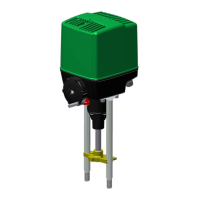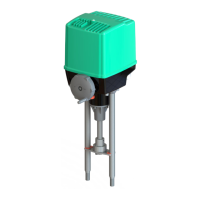3050-8010
Einbau- und Betriebsanleitung
Installation and Operating instructions
Instructions de montage et de service
Regeltechnik Kornwestheim
GmbH
Max-Planck Straße 3
D-70806 Kornwestheim
Telefon +49 7154 / 13 14 - 0
Telefax +49 7154 / 13 14 - 31
Internet www.rtk.de
E-Mail info@rtk.de
- 41 -
8 Empirical optimization
In the absence of system data optimization can be performed empirically with manual trials.
In the trials for empirical optimization the following points are to be considered:
• It must be ensured that the controller output and the controlled variable never reach prohibited levels!!!
• The conditions for the trials should always be identical in order to obtain comparable results.
• The trial procedure must be aimed at the goal of optimization: response to set value changes or interference behavior.
• The controller's operating point must be the same at the trials.
The control parameters are to be set as follows for initial operation:
• Xp as large as possible: on the highest adjustable value,
• Tv relatively large: at most the time needed for the controlled system until the reaction clearly begins.
• Tn large: at most the time the controlled system needs until the reaction is complete.
The time needed for empirical optimization is considerable. To obtain a useful result in a relatively
short time, the following procedure is useful:
ÜTn=Tv=0 and Xp as high as possible (P-control). The Xp is reduced from trial to trial,
as long as the control is sufficiently stable. If it becomes too unstable, the Xp must be somewhat enlarged and
continue with*.
*Measure remaining system deviation: If it is slight enough optimization has been successfully
concluded ( P). If it is too large it is better to regulate the system with PD (set Tv relatively high and
continue with Ö).
ÖReduce Xp from trial to trial until the control is sufficiently stable. If it becomes too
unstable, continue with ä.
ä Reduce Tv and see whether the control can be sufficiently stabilized again.
If so, continue with Ö, if not enlarge Xp a little and continue with #
.
#Determine whether in procedures Ö and ä the Xp was considerably reduced. If so, continue
with<, if not, the system is better controlled with PI (set Tv at 0 and continue with>).
<Measure remaining deviation. If it is slight enough, optimization has been successfully
concluded ( PD). If it is too large it is better to regulate the route with PD (leave Xp and Tv unchanged and
continue with>).
>Tn is set high and reduced from trial to trial, as long as the control is sufficiently stable.
If it becomes too unstable, enlarge Xp a little, and optimization has been successfully concluded
(PID or PI).
Empirical optimization is considerably improved with a recording instrument (or the trend function of the engineering tools) for the
g controlled variable (actual value X) is considerably improved in time used and quality, and the assessment of the
trial results is greatly simplified.
g This procedure can be generalized only with reservations and does not result in significantly improved
behavior on all controlled systems.
Changes to the operating point (Y0), breakover point gap (Xsh)
g lead to results which may be better or worse. With three-step controlllersTm
must be set for the actual running time of the connected positioning motor.
